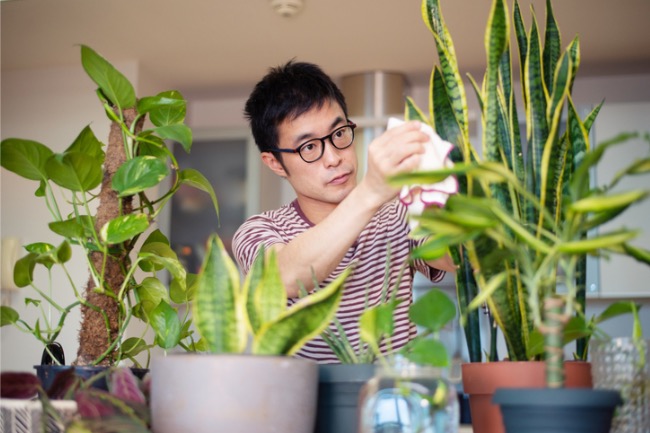

We may earn revenue from the products available on this page and participate in affiliate programs. Learn More ›
With so many of us spending so much time in our homes these days, we’re eager to infuse our spaces with a little natural beauty. That’s one reason why houseplants are hot right now. The vibrant leaves and dreamy drapery of just a single potted plant can transform a room, while a healthy grouping of greenery creates a truly jungle vibe. But as with any living thing, houseplants require proper TLC, and that care should include the occasional dusting.
You’ve probably overlooked the dust that accumulates on your houseplants’ luscious leaves, but rest assured that a clean sweep every now and then will have major benefits for your precious plants—and you, too. Here are three reasons to make dusting your houseplants part of your deep-cleaning routine.
RELATED: 14 Symptoms of an Unhappy Houseplant (and How You Can Treat Them)
1. You’ll Boost Their Health, and Yours!
An accumulation of dust isn’t good for anything! It can trigger your allergies, and it can hinder plants from living their healthiest lives. Leaves that are covered with dust don’t receive the optimal amount of light for photosynthesis, the process by which they create their own food. When this happens, your plants also don’t give off as much oxygen as they could, which means you’re missing out on an important health benefit of owning houseplants—cleaner indoor air.
2. You’ll Keep Up Their Appearance
Sure, you dust your house to reduce allergens, but all that dust is also an eyesore! Whenever you deep clean, going after dirt on baseboards, windowsills, and other less-tended surfaces, add your houseplants to the mix. This will also give you an opportunity to inspect your plants, remove any dead leaves, and check for problems like mold and disease.

3. You’ll Keep Away Pests
A dirty little secret about indoor plants is that they, like their hardier outdoor cousins, can attract gnats and other pests. But if you keep up with regular plant care, including dusting, you can stay on the lookout for changes in leaf color or texture that may be signs that pests have set up residence. Pests are attracted to neglected plants, so to keep them away, make sure your plants are healthy and well cared for.
RELATED: Bug Off: Your Guide to Dealing with Houseplant Pests
How to Clean Your Houseplants
There’s no hard-and-fast rule for how often you should clean your houseplants, but you should at least check them every week. If you notice a buildup of dust, here’s what you should do:
Dust
Depending on the size of the plant, use a microfiber cloth or a dust wand to sweep dust from the leaves and stems. Be sure to support the plant with your free hand to prevent delicate foliage from breaking. A small paintbrush is ideal for dusting cacti or plants with tiny leaves.
Rinse
Use lukewarm water and a washcloth to wipe off the leaves and stems. While you’re at it, also wipe down the plant’s pot. For plants that can handle a healthy dose of water, spray the leaves clean in the kitchen sink or shower. Just be sure that the water is neither too hot nor too cold and that the water pressure is gentle enough not to damage the plant. Allow the plant to air-dry before moving it back to its proper spot in your home.
RELATED: The Best Plants for Every Room of the House

Wash
If your houseplants are especially dirty and water alone isn’t enough, clean them with a solution of lukewarm water and a few drops of dish soap. Dampen a washcloth with the solution and ever so gently scrub the plant clean. When you’re done, thoroughly rinse the plant as described above so you don’t leave soap residue on the leaves.
Avoid Leaf Shine Products
Many houseplants feature naturally shiny leaves that look especially beautiful after a good cleaning. But don’t be tempted to use leaf shine products to enhance your plants. According to The Sill, an online houseplant retailer and info source, these products can actually do more harm than good. Often made with oil or wax, leaf shine products can clog the microscopic pores on a plant’s leaves, making photosynthesis and breathing more difficult for the plant. Instead, step up your houseplant cleaning routine to keep your plant’s leaves glossy.
